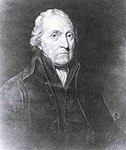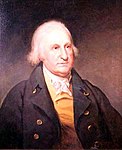1808–09 United States Senate elections
The 1808–09 United States Senate elections were held on various dates in various states, coinciding with the 1808 presidential election. As these U.S. Senate elections were prior to the ratification of the Seventeenth Amendment in 1913, senators were chosen by state legislatures. Senators were elected over a wide range of time throughout 1808 and 1809, and a seat may have been filled months late or remained vacant due to legislative deadlock.[1] In these elections, terms were up for the senators in Class 1.
| |||||||||||||||||||||||||
12 of the 34 seats in the United States Senate (plus special elections) 18 seats needed for a majority | |||||||||||||||||||||||||
|---|---|---|---|---|---|---|---|---|---|---|---|---|---|---|---|---|---|---|---|---|---|---|---|---|---|
| |||||||||||||||||||||||||
 Results: Federalist hold Federalist gain Dem-Republican hold | |||||||||||||||||||||||||
| |||||||||||||||||||||||||
The Federalist Party gained one seat in these elections. The Federalists had gone into the elections with such a small share of Senate seats (6 out of 34, or 18%) that even if they had won every election, they would have still remained a minority caucus.
Results summary
Senate party division, 11th Congress (1809–1811)
- Majority party: Democratic-Republican (26)
- Minority party: Federalist (7–8)
- Other parties: 0
- Total seats: 34
Change in composition
Before the regular elections
| DR7 | DR6 | DR5 | DR4 | DR3 | DR2 | DR1 | |||
| DR8 | DR9 | DR10 | DR11 | DR12 | DR13 | DR14 | DR15 | DR16 | DR17 |
| Majority → | DR18 | ||||||||
| DR27 Pa. Retired | DR26 R.I. Unknown | DR25 Vt. Ran | DR24 Tenn. Ran | DR23 Ohio Ran | DR22 N.Y. Ran | DR21 N.J. Ran | DR20 Md. Ran | DR19 | |
| DR28 Va. Retired | F6 Md. Ran | F5 Del. Ran | F4 Conn. Ran | F3 | F2 | F1 | |||
Result of the regular elections
| DR7 | DR6 | DR5 | DR4 | DR3 | DR2 | DR1 | |||
| DR8 | DR9 | DR10 | DR11 | DR12 | DR13 | DR14 | DR15 | DR16 | DR17 |
| Majority → | DR18 | ||||||||
| V1 Tenn. D Loss | DR26 Va. Hold | DR25 Pa. Hold | DR24 N.Y. Hold | DR23 N.J. Re-elected | DR22 Vt. Re-elected | DR21 Ohio Re-elected | DR20 Md. Re-elected | DR19 | |
| F7 R.I. Gain | F6 Md. Hold | F5 Del. Re-elected | F4 Conn. Re-elected | F3 | F2 | F1 | |||
| Key: |
|
|---|
Race summaries
Except if/when noted, the number following candidates is the whole number vote(s), not a percentage.
Special elections during the preceding Congress
In these special elections, the winner was elected during 1808 or before March 4, 1809; ordered by election date.
| State | Incumbent | Results | Candidates | ||
|---|---|---|---|---|---|
| Senator | Party | Electoral history | |||
| Massachusetts (Class 1) | John Quincy Adams | Federalist | 1803 | Incumbent resigned June 8, 1808, having broken with his party and lost re-election to the next term. New senator elected June 9, 1808 having already won election to the next term, see below. Federalist hold. |
|
| Ohio (Class 1) | John Smith | Democratic- Republican | 1803 | Incumbent resigned April 25, 1808, despite surviving an expulsion trial in the Senate. New senator elected December 10, 1808. Democratic-Republican hold. Successor was also elected the same day to the next term, see below. |
|
| Pennsylvania (Class 1) | Samuel Maclay | Democratic- Republican | 1802 | Incumbent resigned before the December 1808 general election (but effective January 4, 1809), believing he would lose re-election. New senator elected January 9, 1809. Democratic-Republican hold. Incumbent's belief was justified as the successor was elected to the next term, see below. |
|
Races leading to the next Congress
In these regular elections, the winner was seated on March 4, 1809; ordered by state.
All of the elections involved the Class 1 seats.
| State | Incumbent | Results | Candidates | ||
|---|---|---|---|---|---|
| Senator | Party | Electoral history | |||
| Connecticut | James Hillhouse | Federalist | 1796 1797 1803 | Incumbent re-elected in 1809. |
|
| Delaware | Samuel White | Federalist | 1801 (Appointed) 1803 | Incumbent re-elected January 11, 1809. |
|
| Maryland | Samuel Smith | Democratic- Republican | 1802 | Incumbent re-elected November 14, 1809. |
|
| Massachusetts | John Quincy Adams | Federalist | 1803 | Incumbent lost re-election as a Democratic-Republican. New senator elected June 2, 1808. Federalist hold. Incumbent resigned and winner was elected to finish the current term. |
|
| New Jersey | John Condit | Democratic- Republican | 1803 (Appointed) 1803 (special) | Incumbent lost renomination.[8] New senator elected November 3, 1808 on the second ballot.[8] Democratic-Republican hold. |
|
| New York | Samuel L. Mitchill | Democratic- Republican | 1804 (special) | Incumbent lost re-election. New senator elected February 7, 1809. Democratic-Republican hold. |
|
| Ohio | Return Meigs | Democratic- Republican | 1808 (special) | Incumbent elected December 10, 1808. |
|
| Pennsylvania | Samuel Maclay | Democratic- Republican | 1808 (special) | Incumbent retired. New senator elected December 13, 1808 and subsequently elected to finish the remaining term. Democratic-Republican hold. |
|
| Rhode Island | Benjamin Howland | Democratic- Republican | 1804 (special) | Unknown if incumbent retired or lost re-election. New senator elected November 5, 1808. Federalist gain. |
|
| Tennessee | Joseph Anderson | Democratic- Republican | 1797 (special) 1799 (Resigned) 1799 (special) 1803 | Legislature failed to elect. Democratic-Republican loss. Incumbent was appointed to begin the term and was later elected to finish the term. | Election was late, see above |
| Vermont | Jonathan Robinson | Democratic- Republican | 1807 (special) | Incumbent re-elected in 1808. |
|
| Virginia | Andrew Moore | Democratic- Republican | 1804 (Appointed) 1804 (Resigned) 1804 (special) | Incumbent retired.[13] New senator elected in 1809. Democratic-Republican hold. |
|
Special elections during the next Congress
In this special election, the winner was elected in 1809 after March 4; ordered by election date.
| State | Incumbent | Results | Candidates | ||
|---|---|---|---|---|---|
| Senator | Party | Electoral history | |||
| Tennessee (Class 1) | Joseph Anderson | Democratic- Republican | 1797 (special) 1799 (Resigned) 1799 (special) 1803 1809 (Appointed) | Interim appointee elected April 11, 1809. |
|
| Tennessee (Class 2) | Daniel Smith | Democratic- Republican | 1798 (special) 1799 (Resigned) 1803 | Incumbent resigned March 31, 1809. New senator elected April 11, 1809. Democratic-Republican hold. Winner was subsequently re-elected early to the following Congress, see below. |
|
| Rhode Island (Class 1) | Francis Malbone | Federalist | 1808 | Newly seated incumbent died. New senator elected June 26, 1809. Federalist hold. |
|
| Ohio (Class 3) | Stanley Griswold | Democratic- Republican | 1809 (Appointed) | Incumbent appointee retired. New senator elected December 12, 1809. Democratic-Republican hold. |
|
| Georgia (Class 3) | John Milledge | Democratic- Republican | 1806 (special) 1806 | Incumbent resigned November 14, 1809. New senator elected November 27, 1809 on the third ballot. Democratic-Republican hold. |
|
| New Jersey (Class 2) | John Condit | Democratic- Republican | 1803 (Appointed) 1803 (special) 1809 (Lost) 1809 (Appointed) | Incumbent appointee elected November 2, 1809. |
|
Early race leading to the Congress-after-next
In this regular election, the winner was seated on March 4, 1811; ordered by state.
This election involved a Class 2 seat.
| State | Incumbent | Results | Candidates | ||
|---|---|---|---|---|---|
| Senator | Party | Electoral history | |||
| Tennessee | Jenkin Whiteside | Democratic- Republican | 1809 (special) | Incumbent re-elected early October 28, 1809. |
|
Connecticut
Delaware
Georgia (special)
Maryland
| ||||||||||||||||
80 members of the Maryland General Assembly | ||||||||||||||||
|---|---|---|---|---|---|---|---|---|---|---|---|---|---|---|---|---|
| ||||||||||||||||
Samuel Smith was appointed to the seat as opposed to a re-election, due to the State House and State Senate unable to come to an agreement on how to elect a Senator.
Samuel Smith then won re-election over John Eager Howard by a margin of 27.59%, or 24 votes, for the Class 1 seat.[21]
Massachusetts
Massachusetts (regular)
| Party | Candidate | Votes | % | |
|---|---|---|---|---|
| Federalist | James Lloyd Jr. | 248 | 53.68% | |
| Federalist | John Quincy Adams | 213 | 46.10% | |
| Federalist | Laban Wheaton | 1 | 0.22% | |
| Total votes | 462 | 100.00% | ||
Massachusetts (special)
New Jersey
New Jersey (regular)
New Jersey (special)
New York
Ohio
Ohio (specials)
Pennsylvania
Pennsylvania (regular)
Pennsylvania (special)
Rhode Island
Rhode Island (regular)
Rhode Island (special)
Tennessee
Class 1
Joseph Anderson, a Democratic-Republican, held a prominent position in Class 1 of the United States Senate, serving intermittently in both the mentioned Senate seat and the other throughout a substantial period, commencing in 1797. His presence in the Senate reflected his notable political influence and the confidence reposed in him by the electorate. Anderson's periodic service underscored the dynamic nature of early American politics, where individuals frequently transitioned between public service and other pursuits. His extended tenure afforded him the opportunity to contribute to various legislative discussions and debates, leaving a lasting impact on the political landscape during a pivotal era in the nation's history.
Tennessee (regular, class 1)

The Tennessee state legislature encountered a challenge in electing a new senator, resulting in a temporary vacancy in the representation. The seat faced the prospect of becoming officially vacant at the commencement of the term on March 4, 1809. However, in response to the legislative deadlock, the Governor of Tennessee, Willie Blount, took a proactive step and appointed Joseph Anderson to initiate the term on an interim basis. This appointment served as a temporary measure, bridging the gap until a special election could be conducted to fill the senatorial position in accordance with the democratic process.
Tennessee (special, class 1)
Joseph Anderson secured election on April 11, 1809, thereby formalizing his position to complete the senatorial term. This electoral outcome marked the resolution of the previous legislative challenges, as Anderson garnered the necessary support to officially fill the Senate seat.
Class 2
Democratic-Republican Daniel Smith entered the political arena with his initial election in 1803, marking the commencement of his service in public office. His affiliation with the Democratic-Republican party underlines the prevailing political dynamics of the time, as the United States navigated through the early years of the 19th century.
Tennessee (special, class 2)
Smith resigned March 31, 1809.
Democratic-Republican Jenkin Whiteside was elected April 11, 1809 to finish Smith's term, which would end 1809.
Tennessee (regular, class 2)
Whiteside was re-elected early October 28, 1809, unopposed.[20]
Vermont
Virginia
See also
Notes
External links
- Party Division in the Senate, 1789-Present, via Senate.gov


